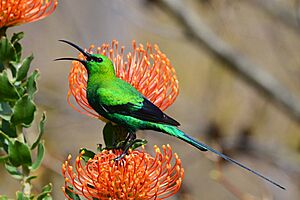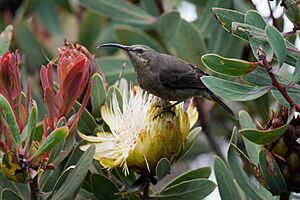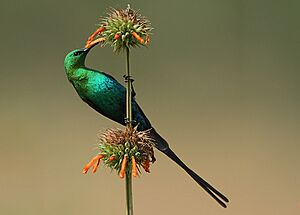Malachite sunbird facts for kids
Quick facts for kids Malachite sunbird |
|
|---|---|
 |
|
| Male in breeding plumage on pincushion protea | |
| Conservation status | |
| Scientific classification | |
| Genus: |
Nectarinia
|
| Species: |
famosa
|
| Synonyms | |
|
Certhia famosa Linnaeus, 1766 |
|
The malachite sunbird (Nectarinia famosa) is a beautiful, small bird that loves to drink nectar from flowers. You can find them in Africa, from the mountains of Ethiopia all the way down to South Africa. They help many flowering plants grow by carrying pollen between them, especially in areas like the Fynbos where special plants with long, tube-shaped flowers grow.
Contents
Meet the Malachite Sunbird Family
Sunbirds are a group of small birds found in Africa, the Middle East, and Southeast Asia. They belong to a bird family called Nectariniidae. The malachite sunbird is sometimes called the green sugarbird because it loves sweet nectar!
Different Types of Malachite Sunbirds
There are two main types, or subspecies, of the malachite sunbird:
- The N. f. famosa lives mostly in South Africa, Lesotho, and western Eswatini. You might also see them in southern Namibia and Zimbabwe.
- The N. f. cupreonitens lives in the highlands, from Ethiopia south to northern Mozambique.
What Does a Malachite Sunbird Look Like?
Malachite sunbirds are easy to spot, especially the males!
Male Malachite Sunbirds
A male malachite sunbird in breeding season is about 25 centimeters (10 inches) long. This includes his very long central tail feathers. His body is a shiny, metallic green. His wings are a blackish-green, and he has small yellow patches on his chest.
When it's not breeding season, the male's upper body turns brown. But his wings and tail stay green, and he keeps his long tail feathers. His belly becomes yellow with some green spots.
Female and Young Malachite Sunbirds
Female malachite sunbirds are smaller, about 15 centimeters (6 inches) long. They have brown upper parts and dull yellow underparts. You might see some faint stripes on their chest. Their tail is shorter and square-shaped. Young malachite sunbirds look a lot like the females.
Where Do Malachite Sunbirds Live and What Do They Eat?
These large sunbirds live in hilly areas with fynbos plants. This includes places with protea flowers and aloe plants. They also like cool mountain and coastal scrublands. You can find them up to 2,800 meters (about 9,200 feet) high in South Africa. They also live in parks and gardens, especially in the Highveld region.
Malachite sunbirds usually stay in one place all year. However, they might move to lower areas during winter.
What's on the Menu?
Like most sunbirds, malachite sunbirds mainly eat nectar from flowers. Nectar is a sweet liquid that flowers make. They have long, thin, curved beaks and brush-tipped tongues. These special tools help them reach the nectar deep inside flowers.
They can hover in the air like a hummingbird to drink nectar, but they usually prefer to perch on a branch. They also eat insects, especially when they are feeding their young. Sometimes, they even catch insects while flying, just like a flycatcher!
They get nectar from many different plants, including various Aloe species like Aloe broomii and Aloe ferox. They also love Protea species and other plants like Leonotis and Strelitzia.
Life Cycle and Behavior
Malachite sunbirds are monogamous, meaning one male and one female pair up.
Nests and Chicks
The female builds an oval-shaped nest, often hanging it from a branch or inside a bush. She lays one to three greenish eggs with dark spots. She sits on the eggs for about two weeks to keep them warm. Both parents feed the chicks until they are old enough to fly. Even after they can fly, the young birds often come back to the nest to sleep.
Malachite sunbirds often have two sets of chicks in a season. Sometimes, other birds like the Klaas's cuckoo or red-chested cuckoo might lay their eggs in a malachite sunbird's nest.
Social Life and Sounds
When they are nesting, malachite sunbirds can be very protective and aggressive. But when it's not breeding season, they are very social. They form large groups, sometimes with over 1,000 birds!
Their call is a loud tseep-tseep. The male malachite sunbird also has a cheerful, twittering song. When he sings, he often points his head up and shows off his bright yellow pectoral tufts (special feathers on his chest) with his wings partly open. Males also perform fancy display flights.
It's interesting that male birds often show their pectoral tufts even when they are sleeping at night. Scientists think these bright spots might look like eyes to scare away predators that hunt at night.





